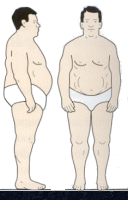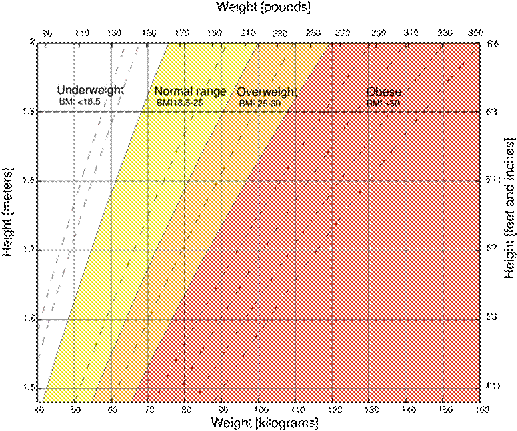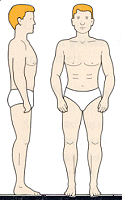


There are three extremes of body types.
 |
Endomorph
|
|
Mesomorph
|
|
Ectomorph
|
Body Size
Body size refers to the athlete's height and weight. The ideal size for an athlete depends on the sport or event and sometimes the position they play in their sport (consider the various body sizes in a Rugby team). There are standard ideal weight charts based on an individual's height. These tables unfortunately do not help athletes because they do not allow for body composition. Being overweight is not a problem provided it is extra muscle and not fat.
Your Ideal Weight
The most accurate assessment of your ideal weight takes into account the composition of your body - how much of your weight is lean body mass (muscle and bone) and how much is body fat. For optimum health, body fat should be no more than 20% of total body weight for men and 30% for women.
Ideal Weight Table
The following table is a guide to a healthy weight range for each height and sex group. The table does not take into consideration your age or your frame size. A person with a petite physique ought to aim for an ideal weight at the lower end of the range. A person of the same height but with a larger frame could quite satisfactorily weigh in at the top of the range.
Height |
|||||
Men |
Women |
||||
Feet & |
Meters |
Kg |
lbs |
Kg |
lbs |
4' 7" |
1.40 |
... |
... |
40 - 53 |
88 - 116 |
4' 9" |
1.45 |
... |
... |
42 - 54 |
92 - 119 |
4' 11" |
1.50 |
... |
... |
43 - 55 |
94 - 121 |
4' 11½" |
1.52 |
... |
... |
44 - 56 |
97 - 123 |
5' ½" |
1.54 |
... |
... |
44 - 57 |
97 - 125 |
5' 1" |
1.56 |
... |
... |
45 - 58 |
99 - 128 |
5' 2" |
1.58 |
51 - 64 |
112 - 141 |
46 - 59 |
101 - 130 |
5' 2½" |
1.60 |
52 - 65 |
114 - 143 |
48 - 61 |
105 - 134 |
5' 3½" |
1.62 |
53 - 66 |
116 - 145 |
49 - 62 |
108 - 136 |
5' 4½" |
1.64 |
54 - 67 |
119 - 147 |
50 - 64 |
110 - 141 |
5' 5" |
1.66 |
55 - 69 |
121 - 152 |
51 - 65 |
112 - 143 |
5' 6" |
1.68 |
56 - 71 |
123 - 156 |
52 - 66 |
114 - 145 |
5' 6½" |
1.70 |
58 - 73 |
127 - 161 |
53 - 67 |
117 - 147 |
5' 7½" |
1.72 |
59 - 74 |
130 - 163 |
55 - 69 |
121 - 152 |
5' 8½" |
1.74 |
60 - 75 |
132 - 165 |
56 - 70 |
123 - 154 |
5' 9" |
1.76 |
62 - 77 |
136 - 169 |
58 - 72 |
128 - 158 |
5' 10" |
1.78 |
64 - 79 |
141 - 174 |
59 - 74 |
130 - 163 |
5' 10½" |
1.80 |
65 - 80 |
143 - 176 |
... |
... |
5' 11½" |
1.82 |
66 - 82 |
145 - 180 |
... |
... |
6' 0" |
1.84 |
67 - 84 |
147 - 185 |
... |
... |
6' 1" |
1.86 |
69 - 86 |
152 - 189 |
... |
... |
6' 2" |
1.88 |
71 - 88 |
156 - 194 |
... |
... |
6' 2½" |
1.90 |
73 - 90 |
161 - 198 |
... |
... |
6' 3½" |
1.92 |
75 - 93 |
165 - 205 |
... |
... |
Body Mass Index:
An alternative way of gauging your weight is to calculate your Body Mass Index (BMI). To determine your BMI divide your weight in kilograms by your height in metres squared. The normal acceptable range of this measurement is 20.1 to 25.0 for men and 18.7 to 23.8 for women. The only exceptions are athletes and body builders, whose extra muscle may tip their BMI over the normal range.
|
BMI Categories:
- Underweight = <18.5
- Normal weight = 18.5-24.9
- Overweight = 25-29.9
- Obesity = BMI of 30 or greater
BMI can also be determined using a BMI chart, which displays BMI as a function of weight (horizontal axis) and height (vertical axis) using contour lines for different values of BMI or colors for different BMI categories.



